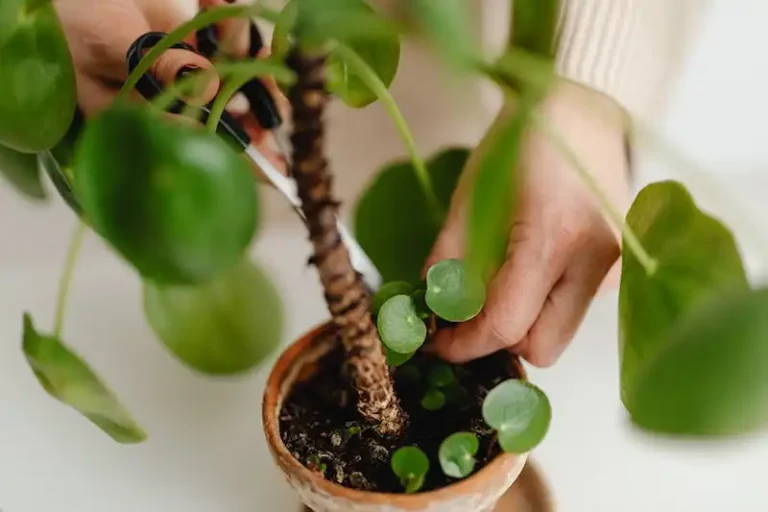Fuchsias are versatile and popular plants that can be grown both in pots and in the garden. These annuals are known for their stunning blooms and trailing growth habit. Fuchsias come in a variety of colors, from the classic red and purple to more unique shades like pink and white. They are a favorite among gardeners who want to add a splash of color to their outdoor space.
When it comes to potting fuchsias, they prefer well-draining soil. A mix of peat and perlite or vermiculite works well. It’s important to choose a pot that has drainage holes to prevent overwatering. Fuchsias like to be kept consistently moist, but they don’t like to sit in water. In addition to proper watering, these plants need to be fed regularly. A light dose of a balanced fertilizer every two weeks will help to maintain their overall health and performance.
To keep fuchsias looking their best, they need regular pruning. This helps to maintain their shape and encourage more blooms. Pruning should be done in late winter or early spring, before new growth begins. Remove any dead or damaged branches, as well as any crossing or overcrowded stems. The goal is to keep the plant open and airy, allowing light and air to reach the inner branches.
During the winter months, fuchsias need to be protected from frost. If the plant is in a pot, it can be brought indoors and placed in a cool, but frost-free location. If the plant is in the garden, it can be covered with a layer of mulch or a frost cloth. In either case, it’s important to water fuchsias sparingly during the winter. Overwatering can cause the roots to rot and the plant to die.
Fuchsias are relatively low-maintenance plants, but they do have a few common problems. One issue is aphids, which can be controlled with a gentle soap and water solution. Another problem is root rot, which can be prevented by ensuring the plant is in well-draining soil and not sitting in water. Finally, fuchsias can sometimes develop fungal diseases, such as botrytis. To prevent this, keep the foliage dry by watering at the base of the plant and providing good air circulation.
In conclusion, fuchsia plant care involves potting them in well-draining soil, maintaining consistent watering and feeding, pruning them regularly, and protecting them from frost. By following these guidelines, gardeners can enjoy the beauty and versatility of fuchsias in their garden year after year.
Growing Fuchsia – How To Keep Fuchsia Blooming All Summer In Hanging Baskets Containers
Fuchsia plants are known for their vibrant and elegant flowers, making them a popular choice for hanging baskets and containers. With the right care and attention, you can enjoy the beauty of fuchsia blooms throughout the summer season. Here are some tips on how to keep your fuchsia plants healthy and blooming:
| Quality Potting Soil | Choose a quality potting soil that is well-draining and rich in organic matter. Fuchsia plants prefer a slightly acidic soil pH (around 6.0-6.5) for optimal growth. |
|---|---|
| Light and Sunlight | Locate your fuchsia plants in a spot where they can receive bright, indirect sunlight for most of the day. They thrive in full or partial shade, especially during the hot summer months. |
| Fertilize Regularly | Fuchsia plants are heavy feeders and require regular fertilization to support their continuous flowering. Use a balanced fertilizer that is specifically formulated for flowering plants. Follow the manufacturer’s instructions for application rates and frequency. |
| Watering and Humidity | Keep the soil consistently moist but not waterlogged. Fuchsias prefer slightly higher humidity levels, so you can increase humidity by misting the leaves daily or placing a tray of water near the plants. |
| Overwintering | In cooler climates, fuchsia plants are not hardy and should be brought indoors or overwintered in a protected area. Reduce watering and place them in a cool, dark location where temperatures stay above freezing. |
| Pruning and Care | Prune your fuchsia plants regularly to maintain their shape and promote bushier growth. Remove any dead or diseased branches, as well as spent flowers to encourage new blooms. Carefully monitor for common pests, and treat them promptly if detected. |
There are different types of fuchsia plants available, ranging from hardy to half-hardy varieties. Choose the type that suits your climate and growing conditions. Some popular fuchsia cultivars include ‘Thompson’s Seedling,’ ‘Beacon,’ ‘Early Orange,’ and ‘Dollar Princess.’
With their versatile nature, fuchsias can be easily grown as evergreen specimens or as annuals in planters and hanging baskets. Their contrasting foliage and stunning flowers make them a superb addition to any garden or outdoor space. Wherever you decide to grow fuchsias, following these care tips will ensure a beautiful and long-lasting display of blooms.
Sue Thompson, a horticulture expert at the Botanical Gardens, recommends using neem oil to keep pests away from your fuchsia plants. Neem oil is a natural and effective solution that can be used to prevent and control common pests like aphids, whiteflies, and spider mites.
How To Keep Fuchsia Blooming Strong
When it comes to keeping your fuchsia plants in full bloom, there are a few key factors to consider. Follow these tips to ensure your fuchsia plants thrive and produce beautiful flowers.
Light and Temperature:
- Place your fuchsia plants in an area with bright but indirect light. Avoid direct sunlight, as it can cause the leaves to shrivel and burn.
- Fuchsia plants are hardy in frost-free areas. If you live in a region with cold winters, consider growing fuchsia plants in containers so you can move them indoors when the temperature drops.
- Fuchsia plants thrive in temperatures between 60-70°F (15-21°C) during the day and around 55°F (13°C) at night.
Watering and Humidity:
- Keep the soil of your fuchsia plants evenly moist, but not waterlogged.
- Water your fuchsia plants thoroughly, allowing excess water to drain away. Empty the saucers under the containers to avoid waterlogged roots.
- Fuchsia plants prefer high humidity levels. Use a humidifier or place a tray filled with water near your plants to increase the humidity around them.
Soil and Fertilizers:
- Plant your fuchsia plants in well-drained soil that is rich in organic matter.
- Choose a slow-release fertilizer formulated specifically for fuchsia plants and follow the instructions on the packaging.
- Fertilize your fuchsia plants every two weeks during the growing season to promote healthy growth and abundant blooms.
Training and Pruning:
- Prune your fuchsia plants regularly to maintain their shape and promote bushy growth.
- To train your fuchsia plants into a standard or obelisk shape, remove the side shoots and allow one main stem to grow upright.
- To encourage more flowers, pinch off the tips of the fuchsia stems.
By following these care tips and providing the right growing conditions, your fuchsia plants will reward you with a flurry of beautiful blooms throughout their blooming season.
Fuchsia Plant Care
Fuchsia plants are known for their stunning, pendulous blossoms, which come in a variety of colors, including the classic fuchsia-colored blooms. Whether you are growing fuchsias indoors or in your garden, here are some tips on how to care for these beautiful plants:
Growing FuchsiasFuchsias grow well in containers, making them popular choices for planters and hanging baskets. They can also be grown in the garden, but they require a bit more care. When choosing a location for your fuchsia plant, look for an area that receives morning sun and afternoon shade, especially if you live in a hot climate. |
|
For indoor fuchsias, place them in a bright, south-facing window where they can get plenty of sunlight. Maintain a temperature between 60-75 degrees Fahrenheit (15-24 degrees Celsius) and keep the soil consistently moist.
Feeding and Fertilizing
Fuchsias are heavy feeders and should be fertilized regularly to promote healthy growth and abundant flowering. Use a balanced, water-soluble fertilizer once a month during the growing season, and reduce the dose in winter.
Watering
Water your fuchsia plants daily, especially during hot and dry weather. They require a lot of moisture, but be careful not to overwater as it can lead to root rot. Make sure the soil is well-drained, and regularly check the moisture level by sticking your finger about an inch into the soil.
Pruning
Fuchsias benefit from regular pruning to maintain their shape and encourage new growth. Prune in early spring or late winter, before new growth starts. Remove any dead or damaged branches, and trim back older growth to promote fresh growth. Pinch back the tips of the branches to encourage bushier growth. Trailing varieties can be trained on obelisks or trellises to create vertical interest in your garden.
Winter Care
Fuchsias are not frost-tolerant, so if you live in an area with cold winters, you will need to bring your plants indoors. Before the first frost, cut back the branches to about 6 inches and remove any leaves. Place the plants in a cool, dark location with temperatures around 40-50 degrees Fahrenheit (4-10 degrees Celsius). Water sparingly to prevent drying out.
In conclusion, fuchsia plants are fairly easy to grow and maintain, as long as you provide them with the right conditions and care. With proper feeding, watering, and pruning, your fuchsia plants will thrive and reward you with their superb blossoms throughout the growing season.
So, whether you’re a seasoned gardener or a beginner, give fuchsias a try and enjoy their beauty in your own garden or on your patio. Happy gardening!
How to grow fuchsias
Fuchsias are beautiful flowering plants that can be grown both indoors and outdoors. They are hardy plants that can thrive in a variety of conditions, making them a popular choice for many gardeners.
To grow fuchsias, follow these simple steps:
1. Choose the right plants: Fuchsias come in many varieties, from upright bush types to trailing varieties that are perfect for hanging baskets and containers. Choose the type that suits your gardening style and preferences.
2. Provide the right conditions: Fuchsias prefer partial sunlight and well-drained soil. They can tolerate a range of temperatures, but prefer to be kept frost-free.
3. Plant the fuchsias: Fuchsias can be planted in the ground or in containers. Make sure to provide enough space for the plants to grow and spread. Use a balanced fertilizer to promote healthy growth.
4. Water and fertilize: Fuchsias need regular watering, especially during dry spells. However, be careful not to overwater, as fuchsias can easily become waterlogged. Fertilize the plants every 2-4 weeks with a fuchsia-specific fertilizer to keep them thriving.
5. Watch for diseases: Fuchsias are prone to some common diseases, such as rust and gray mold. Keep an eye out for any signs of disease and treat them promptly to prevent further damage.
6. Prune and deadhead: Regular pruning and deadheading will help keep your fuchsias in shape and encourage more flowers. Remove any wilted or faded flowers to make way for new buds.
7. Overwinter the plants: In colder climates, fuchsias need to be protected from frost. Bring potted fuchsias indoors and provide some insulation for outdoor plants. Reduce watering and stop fertilizing during this time.
By following these tips, you can enjoy the beauty of fuchsias in your garden or home throughout the growing season. For more detailed information, you can also check out online resources or consult gardening experts like Sue Sanderson or Morgan Bell at your local botanical center.



